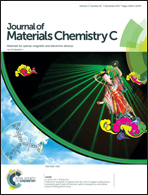A novel bipolar D–π–A type phenanthroimidazole/carbazole hybrid material for high efficiency nondoped deep-blue organic light-emitting diodes with NTSC CIEy and low efficiency roll-off†
Abstract
Tremendous efforts have been devoted to developing efficient deep-blue organic light-emitting diodes (OLEDs), but deep-blue OLEDs with high external quantum efficiency (EQE) and CIEy < 0.10 (Commission Internationale de L’éclairage (CIE)), especially matching the National Television System Committee (NTSC) standard blue CIE (x, y) coordinates of (0.14, 0.08), are still limited. Herein, we report the synthesis, photophysical properties, thermostability and electrochemical characterization of two phenanthroimidazole/carbazole-based compounds (CBPMCN and CPBPMCN). Single X-ray crystal data of CPBPMCN indicate that it adopts a severely twisted structure, resulting in a low degree of intermolecular π–π stacking, which is appropriate to be employed as a nondoped deep-blue emitter. Nondoped devices based on CPBPMCN exhibited deep-blue electroluminescence (EL) with CIE coordinates of (0.15, 0.08), which is extremely close to the NTSC standard blue. Meanwhile, the devices showed impressively high EQEmax up to 5.80% with relatively small efficiency roll-off.



 Please wait while we load your content...
Please wait while we load your content...